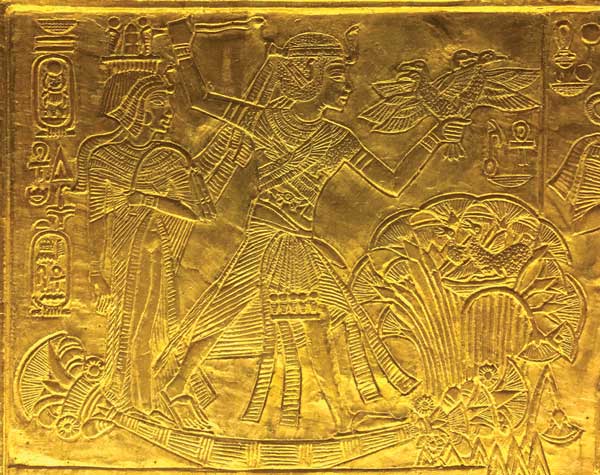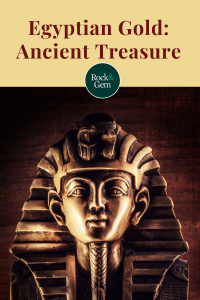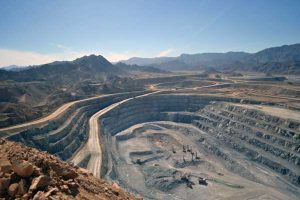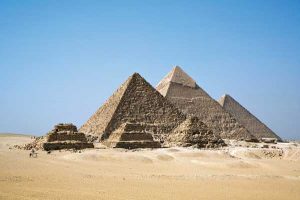
Egyptian gold is probably best symbolized in the 3,500-year-old funeral mask of the pharaoh, Tutankhamen. Inlaid with a dazzling array of gemstones and gem simulants, this golden mask is one of the world’s most well-known works of art.
To the Egyptians, gold, as the color of the sun, was the flesh of the sun god Ra and represented eternal life. The colors of the mask’s gemstones—red, green, and two shades of blue—have great significance in ancient Egyptian symbolism. Red symbolized life-sustaining blood, power, and vitality; green stood for fertility, lush vegetation, joy, and rebirth in an afterlife. Light blue symbolized primordial waters and the daytime sky, dark blue the all-embracing and protecting night sky.
Locating Egyptian Gold

In the early Predynastic Period (about 3100 BCE), Egyptians became the first culture to mine and work gold on a large scale, obtaining gold from placer deposits and as fl from eroded quartz veins. By the time of the New Kingdom (1570 BCE), gold mining had evolved into a royal monopoly with slaves laboring in hundreds of small hard rock mines.
Almost all of Egypt’s gold mines, and its later gemstone mines, were located in the Eastern Desert, the arid expanse of barren ridges and wadis (seasonally dry ravines) between the Nile and the Red Sea. Geologically, the Eastern Desert forms part of the western edge of the 4,200 mile-long Great Rift Valley, the Earth’s largest crustal rift that is the key to Egypt’s gold mineralization.
Geologic Rifts
Geologic rifts are separations in the crust that appear as long, linear surface depressions. Rifts form when tectonic plates drift apart or when uplifting “domes” break the rigid crust. The Red Sea section of the Great Rift Valley began forming 55 million years ago when the African and Asian plates collided, then separated.
As separation progressed, long, narrow, crustal blocks between the two plates subsided to create the depression now filled by the Red Sea.
The Red Sea is the Great Rift Valley’s most prominent topographic feature. The crustal faulting and fracturing that accompanied its formation provided conduits for intrusive and extrusive igneous activity.
Associated mineral-rich hydrothermal fluids emplaced veins of gold-bearing quartz. These veins, eventually exposed by erosion, were the source of Egypt’s gold.
Royal Egyptian Gold
By the time Egypt had attained its height of cultural development in the New Kingdom, its gold workers had mastered the techniques of fusing, lost wax casting, engraving, embossing, and hammering the metal into thin, workable sheets. They turned most gold into jewelry for royalty and the elite, and into decorative and ceremonial objects to adorn temples and accompany deceased royalty into their tombs.
Gold from the Eastern Desert contains varying amounts of silver, sometimes more than 20 percent. Although lacking the metallurgical ability to separate the silver, the Egyptians were aware that varying silver content produced gold of different colors. They used this knowledge artistically in Tutankhamen’s funeral mask.
Tutankhamen’s Funeral Mask

Many of ancient Egypt’s most prized gemstones and gem simulants appear in Tutankhamen’s funeral mask. English archeologist and Egyptologist Howard Carter recovered the mask in 1923 from a tomb in the Theban Necropolis in the Valley of the Kings, an ancient burial site near the present-day city of Luxor (formerly Thebes). It was one of the few tombs that had not been previously looted.
Archeologists believe the face of the mask combines the imagined physical features of Osiris, the Egyptian god of the afterlife, with those of Tutankhamen. The mask is 22 inches high, 15.5 inches wide, and 19 inches deep; it weighs 22 pounds, with gold accounting for 95 percent of its weight. It consists of two types of gold sheets between one and three millimeters (.04 to .12 inches) thick. Most of the mask is 22.5-karat gold but, in an artistically brilliant touch, the face is 18.4-karat gold which, with its lighter color, gives the face a subtle, life-like radiance.
Gems of the Mask
The mask is inlaid with hundreds of pieces of semiprecious gemstones, faience, and glass. The eye outlines are of lapis, the iris and pupils of milky quartz and obsidian, and the elaborate collar consists of rows of cylindrical bits of red carnelian, green turquoise, blue-green amazonite, and blue and green glass and faience. The striking blue stripes in the headdress that appear to be lapis are instead dark-blue glass.
That gold was abundant during the New Kingdom is evident in Tutankhamen’s five-room tomb, which was filled with hundreds of solid-gold and gold-gilded objects from large chariots to tiny figurines. The interior coffin of the pharaoh’s three-part sarcophagus consisted of 240 pounds (2,880 troy ounces) of gold that would be worth $5.7 million today.
Mining Gold

Despite its advanced gold-working methods, ancient Egypt’s mining technologies remained primitive. Slaves broke rock with handheld or hafted stone mauls. Most mines were surface pits and trenches, although slaves also drove narrow workings hundreds of feet underground to follow gold-bearing quartz veins. Slaves manually crushed the ore, then recovered the gold by dry shaking or by hauling the ore 50 to 100 miles to wash it in the waters of the Nile. Egypt’s first significant mining advancement was the introduction of iron (actually low-grade carbon steel) tools during the Late Period.
Just how much gold the ancient Egyptians mined will never be known, but the German geological-archaeological research team of geologist Dietrich Klemm and Egyptologist Rosemarie Klemm estimates the total Egyptian production at 7.1 tonnes, or roughly 227,200 troy ounces.
Historically, this would amount to most of the gold mined worldwide before Roman times. From a modern perspective, it is surprisingly little, amounting only to the output of a modern, medium-sized, open-pit gold mine for a single year.
Turin Papyrus Map
Ancient Egypt’s gold-mining history is undocumented except for the Turin Papyrus Map. Drawn about 1150 BCE to support a 5,000-man quarrying expedition to obtain sandstone blocks for royal sculptures, it is now displayed in the Museo Egizio in Turin, Italy.
The six-foot-long Turin Papyrus Map, the world’s oldest known topographical and geological map, depicts stone quarries and numerous gold mines along a nine-mile section of the Eastern Desert’s Wadi Hammamat mining area. It accurately presents different rock types as black and pink hills and depicts lithologi- cally diverse wadi gravels as varicolored dots. It even provides textual information on quarrying and gold mining.
Egyptian Gold Today

Today, Egypt still produces gold. The nation’s first modern gold mine, the Sukari Mine, began production in 2010 in the Eastern Desert where gold was first mined more than 5,000 years ago. That the ancient Egyptians left much low-grade gold behind is apparent in Sukari’s production figures: the mine has already recovered four million troy ounces of gold and has twice that amount as ore reserves waiting to be mined.
Tutankhamen’s tomb may even yield a few more surprises. Recent work with ground-penetrating radar indicates that two chambers remain hidden behind the tomb. While it is unlikely that these chambers will yield another golden funeral mask, their contents may add yet another chapter to the story of ancient Egypt’s experience with gold and gemstones.
This story about Egyptian gold previously appeared in Rock & Gem magazine. Click here to subscribe. Story by Steve Voynick.













